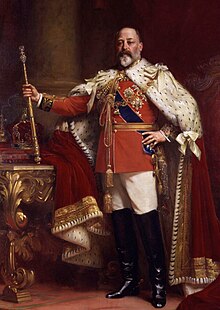| Edwardian era | |||
|---|---|---|---|
| 1901–1910 | |||
 | |||
| Monarch(s) | |||
| Leader(s) | |||
Chronology
| |||
| Periods in English history |
|---|
| Timeline |
In the United Kingdom, the Edwardian era was a period in the early 20th century, that spanned the reign of King Edward VII from 1901 to 1910. It is commonly extended to the start of the First World War in 1914, during the early reign of King George V.
The era is dated from the death of Queen Victoria in January 1901, which marked the end of the Victorian era. Her son and successor, Edward VII, was already the leader of a fashionable elite that set a style influenced by the art and fashions of continental Europe. Samuel Hynes described the Edwardian era as a "leisurely time when women wore picture hats and did not vote, when the rich were not ashamed to live conspicuously, and the sun never set on the British flag."[1]
The Liberals returned to power in 1906 and made significant reforms. Below the upper class, the era was marked by significant shifts in politics among sections of society that had largely been excluded from power, such as labourers, servants, and the industrial working class. Women started (again) to play more of a role in politics.[2]
- ^ "Manor House. Edwardian Life | PBS". PBS.
- ^ Hattersley, Roy (2004). The Edwardians.